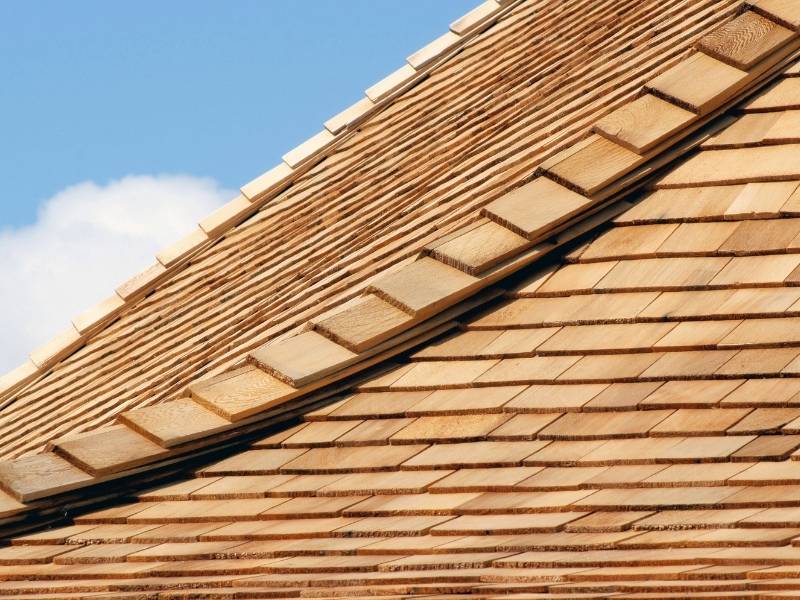When looking at a house, people’s eyes eventually take in the roof. They notice its color, shape, whether there is a chimney, gables, or skylights, as well as the condition of the shingles. What they don’t understand is that they are only looking at the surface. Underneath the shingles is where moss and stains are hiding away. But, unfortunately, most homeowners miss the hidden cast members that play a supporting role in the spread of moss and stains.
But let’s give credit where credit is due — to the shingles. These small segments of durable materials installed on top of the underlayment, sheathing, and trusses of the roof take the brunt of Mother Nature while at the same time contributing to the attractiveness of the home. Although there are six shingle material choices available to homeowners, the majority of roofs in the U.S. are covered with either asphalt or wood shingles.
This article covers descriptions of asphalt and wood roofing materials. In addition, we also go over moss and stains and how to treat them effectively. This is a topic that affects all homeowners so you are invited to continue reading to learn some useful facts about your roof.
Asphalt & Wood Roofing • How to Treat Moss and Stains

Asphalt Roofing Material
Composed primarily of asphalt but reinforced with fiberglass and/or organic material like cellulose or wood, asphalt shingles come in a variety of colors and sizes and are particularly popular in the Northeast and Northwest because they stand up well to rain and moderate amounts of hail and are strong and flexible enough to bear the weight of snow. Those are their advantages. Their disadvantages are that they tend to buckle and become loose when exposed to sudden fluctuations in temperature and high winds. And while they show a brave front in the face of rain, fog, and snow, the resulting moisture, makes them ideal growing spots for moss and mildew. Asphalt roofing shingles can be further broken down into three design types, three-tab, multi-layered, and architectural. Each has its advantages and disadvantages.
Wood Roofing Material
Wood shingles can be made of cedar, pine, or spruce that has been machine cut for uniformity, This type of shingles, although they cost a bit more than asphalt shingles are still economical. Plus they’re environmentally friendly. Unfortunately, the environment is not always friendly to them. They are vulnerable to a number of things found in nature including hail and termite. And of course, they are not fire-proof’ So unless they have a class A fire-proof rating wood shingles are not a good match for hot dry climates. And since they are prime for mold and mildew, they’re not good in wet climates either.
The build-up of moss and mildew seems to be the common denominator here. In fact, out of the thirty-one most asked questions, This Old House includes in a recent article, two pertain to the presence of moss and black stains. Concerned homeowners want to know whether, other than their unsightly appearance, moss and mildew are harmful to the shingles. The verdict? One is. The other isn’t.
Stains Get a Pass
While it was not a matter of thumbs up, This Old House gave the stains a pass, explaining that the stains are caused by moisture-seeking algae that feed on the minerals making up the shingles. However, ugliness aside, they are not bad for the roof and can easily be washed off as a do-it-yourself remedy. All it takes is a pump sprayer holding a 2:1 solution of bleach and water and a window-washing brush on a telescoping pole extension. And as a bit of prevention, homeowners can install strips of copper or brass to the peak of the roofs, either of which would release algae-inhibiting ions that would cascade over the shingles with each rainfall.
Moss is a Different Story
By contrast, the verdict on moss was guilty on all counts. Not only does moss sprouting on roofs detract from the house’s appearance and curb appeal, but, in addition to moisture retention that shortens the life of shingles, moss invites other interlopers like twigs, bird debris, dirt, and leaves all adding to the accumulation of moisture. The longer the moss stays, the sooner the shingles blister and/or curl up, eventually resulting in a leaking roof.
The good news is that although it takes a bit more than in the case of stains, you can remove moss before it does its damage. However, if a closer examination shows the surface granules wear off, the shingles lose their protection. Then, it’s time to look at the prospect of new roofing. Either that or another solution like this — a roof over.
A Roof Over?
A roof over is a more affordable option for tearing down the outer layers of your roof. By placing new materials over the existing ones, a roof over adds a second layer of leak prevention. But the resulting combination of old and new shingles also strengthens the roof. So whether you get a new roof or a roof over, then, you must consult reputable roofing professionals.
Do you have questions? If so, we’d love to hear from you in the comments below. Also below, are links that take you to more articles about ALL things DESIGN for your home or business.
Images Courtesy of Canva.
Other Posts You Might Enjoy:
Winter Proof Your Garden: 5 Tips!
The Dos and Don’ts of Hiring Roofers in Montgomery County PA





